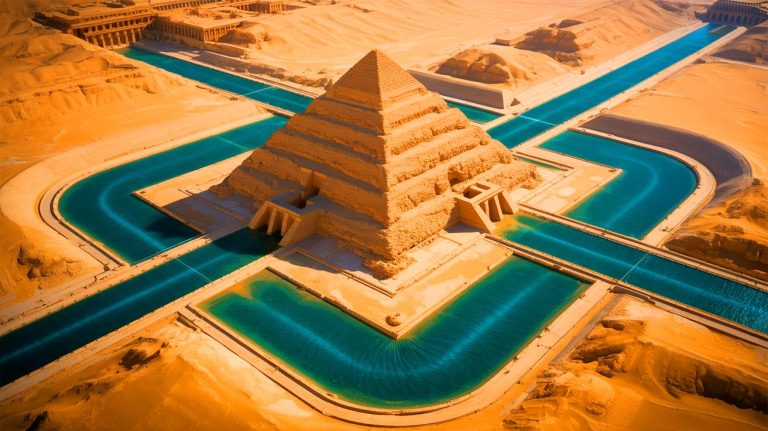| IN A NUTSHELL |
|
Deep in the heart of the Egyptian desert, a groundbreaking discovery is transforming our perception of the ancient world. Researchers have uncovered a sophisticated water management system surrounding the Pyramid of Djoser, challenging long-held beliefs about the construction methods of ancient Egyptian builders. This intricate network, featuring elements such as a stone dam, underground basins, and a labyrinth of galleries, reveals a level of technical organization and ingenuity that was previously unimaginable. These findings illuminate a forgotten knowledge that may have enabled one of history’s most extraordinary architectural accomplishments amid a harsh, arid landscape.
Ingenious Stone Dam Capturing Desert Floodwaters
The enigmatic structure at Saqqara, known as Gisr el-Mudir, has long puzzled researchers with its vast size and unclear purpose. Spanning nearly 1,180 feet, this ancient stone enclosure is one of Egypt’s oldest constructions. Recent research, spearheaded by Xavier Landreau and his team from the CEA Paleotechnic Institute and published in PLOS ONE, suggests that this edifice served as a dam to capture seasonal floodwaters from nearby wadis, rather than being a ritual or defensive structure as previously thought.
By analyzing terrain slopes, ancient watercourses, and visible erosion marks, the researchers reconstructed a watershed capable of channeling water to the enclosure, which would have acted as a temporary reservoir. The stone dam was capable of holding up to 14 million cubic feet of water, sufficient to support large-scale construction projects. Seasonal floods would also deposit sediments in naturally arranged basins downstream, further enhancing the site’s utility. This discovery repositions Saqqara’s role in Egyptian history, suggesting its location was chosen not only for religious or political reasons but also for geological and hydrological considerations.
How Hydraulic Construction of Pyramids Worked
While having a sufficient water supply stored upstream was crucial, it wasn’t the sole factor needed to lift the massive limestone blocks. The secret to this lies within the depths of the Djoser complex. South of the monument, a vast trench carved into the rock, once thought to be symbolic, reveals a series of interconnected basins and compartments. Known as the “Deep Trench,” this network functions as a water treatment system. Heavier sediments settle first, gradually clarifying the water before it’s transferred further.
This purified water likely powered a vertical lifting system beneath the pyramid. Two vertical shafts, connected by a 656-foot-long underground gallery, would have enabled a flotation device. Blocks placed on a floating platform would be elevated by the simple pressure of water injected into the shafts. Once the load reached a sufficient height, it could be slid onto the upper tiers of the monument. The observed structures in the galleries and underground compartments support this hypothesis, revealing a system akin to a hydraulic elevator, utilizing water’s force to reduce mechanical effort.
Sophisticated Technology Matching Pharaohs’ Ambitions
Though the hydraulic construction hypothesis may seem bold, it is grounded in concrete evidence observed on-site. The dam, basins, galleries, and shafts all present a logical organization compatible with a hydraulic chain. Contrary to popular belief, the Egyptians had already mastered numerous water-related techniques. Their expertise in irrigation canals, wooden gates, and agricultural dams speaks to a well-established hydraulic knowledge. This study goes further, showing that such a system could reduce the need for massive external ramps, significantly lowering labor demands and logistical constraints. The project would gain efficiency, safety, and precision.
This advanced engineering level prompts researchers to reconsider other Old Kingdom monuments. The Pyramid of Djoser, often seen as a prototype, may have been the culmination of a highly developed technology that later dynasties struggled to replicate. This revelation challenges the narrative of pyramid construction, suggesting a blend of ingenious engineering and resourceful adaptation to environmental challenges.
How Saqqara’s Hydraulic Remains Alter Our Historical Perspective
Until now, pyramids were studied almost exclusively from a symbolic or architectural standpoint. The discovery of such an extensive and integrated hydraulic system opens new avenues for exploration. It reveals that builders of the era were not merely executing a religious project but were also crafting a sustainable technical ecosystem, adapted to the environment and available resources.
This multidisciplinary approach, combining archaeology, hydrology, and geotechnics, enriches our understanding of the past. It unveils a sophisticated work organization, rigorous material management, and a nuanced exploitation of the territory. It’s now conceivable that the pyramids were not solely the result of a massive labor force mobilization but also the outcome of an underestimated technical genius. This perspective sheds new light on ancient Egyptian innovation and invites us to reassess other monumental sites, seeking similar traces of buried or forgotten hydraulic systems.
As we uncover more about the ancient Egyptians’ ingenious engineering, we are left to wonder: What other hidden technological marvels lie beneath the sands, waiting to rewrite history once more?
Did you like it? 4.5/5 (20)







Wow, this is mind-blowing! I always thought aliens built the pyramids! 😂
Can someone explain how the hydraulic system worked? I’m a bit confused. 🤔
It’s amazing to think they might have used water power! What other secrets does history hold?
This is just another way to undermine traditional views. 🤨
Thanks for shedding light on this topic. It’s incredible to learn about ancient engineering!
Is there any evidence that other pyramids used the same techniques?
So, no aliens? 😏
I wonder how they discovered this. Were there any ancient texts mentioning water systems?
Next, they’ll tell us the Sphinx is a water fountain! 🙄
Fascinating! Thanks for sharing this discovery. It really makes you think.